Canon PowerShot SX260 HS Review
Canon PowerShot SX260 HS
Canon's new flagship travel compact offers a 20x optical zoom and is a great little all-rounder.
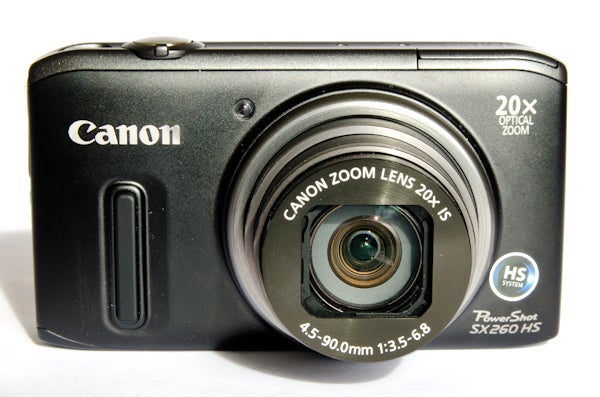
Verdict
Pros
- Huge zoom range offers plenty of flexibility
- Class-leading build quality for a travel compact
- Well featured and easy to use
- Creative Controls offer easy creative fun
Cons
- Lacks a one-touch Panorama mode
- Processing times in Single-shot mode a little slow
- AF not as quick as the competition
Key Specifications
- Review Price: £300.00
- 12.1MP backside-illuminated CMOS sensor
- 20x optical zoom (equiv to 25-500mm in 35mm terms)
- 1080/24p Full HD movie recording
- Built-in GPS functionality
- Creative Control digital filters
- 10fps High-Speed Burst Shooting
The Canon SX260 HS is the latest flagship travel compact to grace Canon’s perennially popular PowerShot compact range and comes with a 20x optical zoom, GPS functionality and the ability to record Full HD movies at 24fps.
The SX260 replaces the SX230 that we reviewed last year as the top model in Canon’s travel compact range and brings with a number of upgrades. Most notable of these is the extension of the optical zoom from 14x to 20x, giving the SX260 a hugely flexible 35mm focal range equivalent of 25-500mm – enough to capture wide-open landscapes and also to pick out individual details within a scene. In addition the new model also benefits from the welcome addition of a finger grip.
Effective resolution remains at 12.1MP, which strikes us as quite a sensible move given that the SX260 uses a regular 1/2.3in compact-sized sensor. As per the SX230, the SX260’s CMOS sensor is of the backlit variety, which basically means the wiring sits on the underside of the chip rather than on top. This arrangement has become increasingly common with compact manufacturers in recent years because it enables more light to reach the sensor, which in turn leads to improved performance in low light. ISO remains the same as the SX230 with a standard range of ISO 100 to 3200, with an extended High Sensitivity setting of ISO 6400 also available – albeit at a lowered resolution of 3MP.
In addition, the new model also benefits from Canon’s latest DIGIC 5 image processor. This is notably faster than the DIGIC 4 processor employed by the SX230 and as such, allows the SX260 to shoot at a maximum 10fps in High-Speed Burst mode – as opposed to the 8.1 frames-a-second the SX30 was capable of. 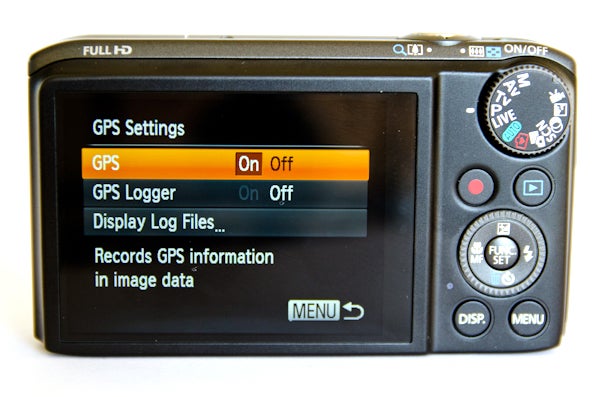
The SX260 offers a good range of exposure modes that include the same Program, Aperture-priority, Shutter-priority and Manual (PASM) quartet found on DSLRs and other advanced cameras. The SX260 isn’t particularly fast, however, with a maximum aperture that runs from f/3.5 at wideangle, stopping down to f/6.8 at the camera’s maximum telephoto reach. Still, given the not insignificant engineering feat of cramming a 20x optical zoom into a camera not much bigger than a regular ultracompact we’re not going to complain too loudly about this.
Other exposure modes include a Smart Auto scene selector mode (that has 58 pre-programmed scenes to choose from); an Easy mode that effectively disables access to the Quick Menu for hassle-free point-and-shoot photography; a Live View mode that uses simplified on-screen sliders for easy control over exposure, vibrancy and white balance; a Movie Digest mode that automatically records a short video clip every time a still image is taken; and a Discreet mode for silent/flash-free operation.
In addition the SX260 also offers 10 individually selectable Scene modes that includes the aforementioned High-Speed Burst mode, along with a couple of dedicated portrait modes. You’ll also find a Panorama assist mode, although this isn’t the same one-touch sweep mode found on Sony and Panasonic compacts, but rather a basic framing guide that helps you to frame consecutive shots. In other words, you’ll need to do the actual stitching together of images yourself afterwards in Photoshop or suchlike. 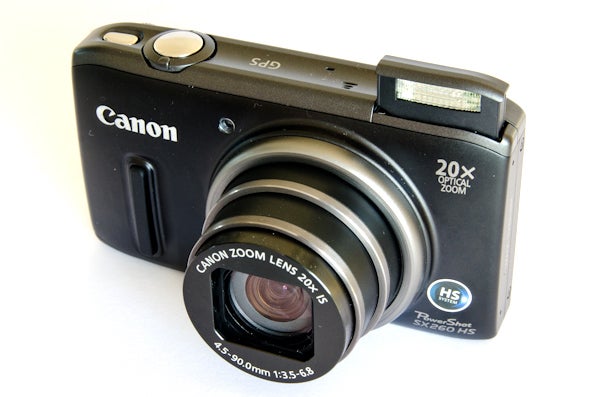
Last but not least are nine Creative Filter digital effects: Fish-eye Effect, Miniature Effect, Toy Camera Effect, Soft Focus, Monochrome, Super Vivid, Poster Effect, Color Accent, and Color Swap. These are quite fun to play around with and can be used to add a bit of fun to your images without any need for fancy image editing software.
Movie recording options are solid enough with a top setting of 1080/24p Full HD, ably supported by 720p HD and 640 x 480 VGA standard definition options. Audio is recorded in stereo via two microphones positioned on the top of the camera and files are stored in the H.264 .MOV format.
Overall build quality is very high indeed, and just tops of its class, with the SX260 benefitting from a predominantly metal outer shell. While this does make it a little heavier than some rival travel compacts such as the Panasonic Lumix TZ30 and Sony HX20V, the payoff is a camera that feels especially solid and well built in the hand. We should stress that the extra weight isn’t really a problem, and at just 230g including card and battery the SX260 certainly isn’t going to weigh you down. It’s a subjective matter of taste of course, but we think the anodised matt finish on the black review sample we were sent looks pretty stylish too.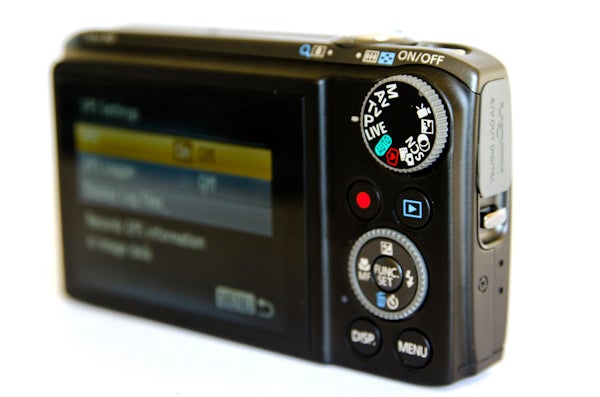
Whereas the SX230 we reviewed last year lacked a finger grip and felt a bit slippery, the SX260 gets a raised hard plastic ridge on the front that you can use to wrap your middle finger around. There’s no thumb rest on the back, however the exposure mode dial is located in about the same position and is quite chunky, which means you can easily brace your thumb against it. Thankfully the exposure dial is pretty stiff to turn so you’re very unlikely to accidentally change shooting modes while using it as a thumb rest. Overall, we found that the SX260 offers a really comfortable and secure grip that easily allows it to be used one-handed – in this respect it’s certainly a big improvement over the SX230.
Buttons are well laid out and easy to reach, and the SX260 also gets the rotating wheel around the D-pad that will be instantly familiar to anyone who’s previously used a Canon camera. The Func/Set Button in the middle of the D-pad can be used to access a quick menu that opens up a range of shooting options down the left-hand side of the 3in, 460k-dot screen. As ever, the number of options available in the quick menu is dependant on the shooting mode the camera has been set to. Should you want to make more in-depth changes then there’s also a main Menu button that opens up a more in-depth but still easy-to-navigate in-camera menu. Overall, it’s a very easy camera to use and even those unfamiliar with Canon cameras should get to grips with it pretty quickly.
Start-up time for the SX260 clocks in at a fraction under 2.5seconds, which isn’t too bad for a compact of this kind. Processing speeds are a little underwhelming though, which comes as something of a surprise given the SX260’s speedy DIGIC 5 processor. Used in Single-shot drive mode you can expect to wait around 2.5seconds in between shots, during which time you’re unable to shoot any new pictures. Switching to regular Continuous drive mode enables a capture rate of around 2.2fps; we managed 22 images over a timed 10-second burst. In Continuous drive mode with constant AF this does drop quite significantly to around 1fps, or 10 frames in 10secs. Used in High-Speed Drive Mode (accessed via the Scene mode sub-menu) the SX260 is good for the claimed 10fps, but only to a maximum of 10 frames at a time. 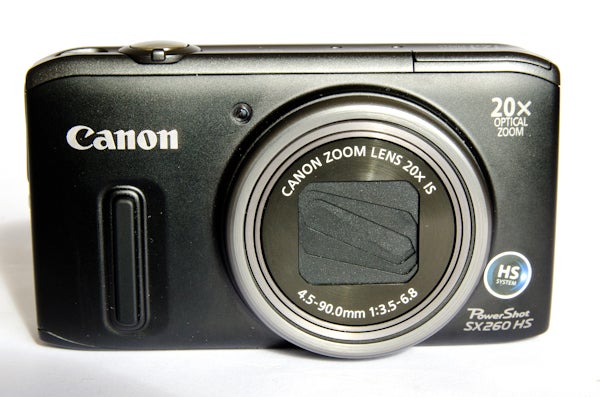
Autofocus options are a bit limited; in all of the SX260’s more automated point-and-shoot exposure modes the camera will automatically select its own AF points. This means that when you’re faced with a complicated scene there’s no guarantee that the camera will focus on what you want it too – although, of course, this is a charge that can be levelled at most compacts sporting automatic AF. If you’re primarily shooting people then it will definitely pay to switch on the camera’s Face Detection priority function.
Using the camera in one of the more advanced shooting modes does offer a choice of Single-point AF (centre), Face Detection AF priority, and Tracking AF. The first of these lends itself well to the focus-recompose technique, while the Tracking function is pretty reliable too, just so long as your subject isn’t moving too quickly or erratically. There’s also a Manual focus option that opens up an enlarged focus box in the centre of the LCD screen. From here you simply use the rotating thumb wheel to focus. It’s a bit tricky and rather slow, but could occasionally prove useful for shooting still-life scenes with.
Regardless of which mode you use AF speed is a bit of a mixed bag – outdoors in good light it’s almost instant as you might expect, although the Lumix TZ30’s ‘Light Speed’ AF module still has the edge for speed. In poor light, or indoors under dim artificial lighting the SX260’s autofocus is noticeably slower, although still generally quite reliable. In really dark conditions a green AF assist light on the front of the camera can be switched onto help out.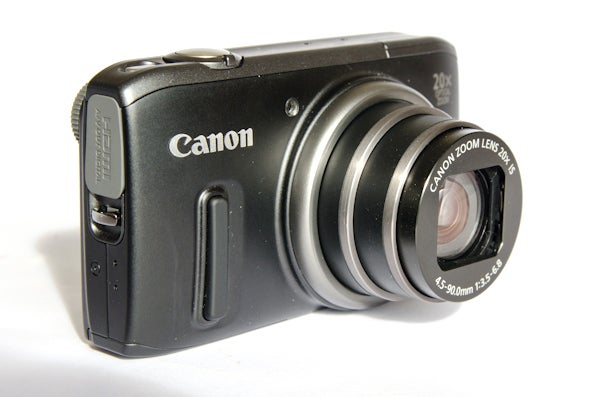
The SX260’s 20x zoom extends from 25mm to 500mm in two seconds flat when the rocker switch is fully held down. Feathering the zoom rocker for more precise control we counted approximately 35 individual stops between the two extremes. The zoom operation is smooth throughout the range, but also quite noisy – if you are recording video then the camera’s built-in microphones will easily pick up the internal mechanical whirring. We do like how the camera displays the minimum focus distance as you extend or wind the zoom in.
In addition to the optical zoom, the SX260 also offers a number of digital zoom functions. These include 1.5 and 2x ‘teleconverter’ options (which essentially magnify the optical zoom by those amounts) along with a standard digital zoom setting that extends its reach right up to 80x. As might be expected image quality on all three options does take a hit the more you zoom in/magnify the image – at 35x images are pretty good (so long as you don’t intend to make large prints from the,) but at 80x images look pretty dreadful even when viewed small.
This being a Canon compact it should come as no great surprise to learn that overall image quality is very good indeed. As with most Canon cameras the SX260 offers a number of ‘My Colours’ JPEG processing profiles, each of which produces a slightly different overall look; from the super saturated tones of ‘Vivid’ to the much more muted palate of ‘Neutral’. During testing we mostly kept the function switched off, although we have found ourselves partial to the richly toned ‘Positive Film’ setting on occasion. There’s also a ‘Custom’ setting that you can tinker with to find your own happy medium with.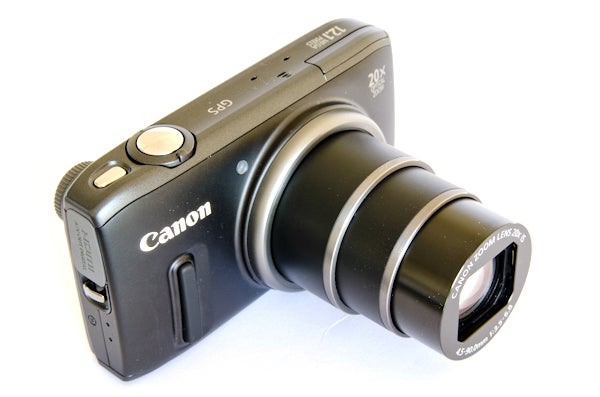
Straight out of the camera with My Colours switched off, the SX260 delivers pleasingly lifelike colour that’s neither too saturated nor too muted. Metering is generally very accurate too, albeit with the occasional tendency to slightly overexpose – especially in bright conditions. Automatic white balance is consistently well metered, although you can of course force the camera to your desired setting. Smart Auto and Live View exposure modes both offer some simplified on-screen slider controls that can be used to tweak white balance as you see fit, so you don’t necessarily need to be an expert in colour temperature to get the look you want.
The SX260 benefits from Canon’s own Image Stabilisation (IS) technology and we definitely found that it helped us to take sharper images, especially at wideangle and mid-range zoom settings. Shooting handheld at 500mm is always going to prove problematic, even for the most advanced stabilisation technology available, and while the SX260’s lens doesn’t do a bad job at the furthest reaches of its range, it doesn’t quite produce the sharpest results either. In addition, we also noticed some instances of purple fringing on high-contrast borders, although this is something that isn’t uncommon to superzoom lenses like this.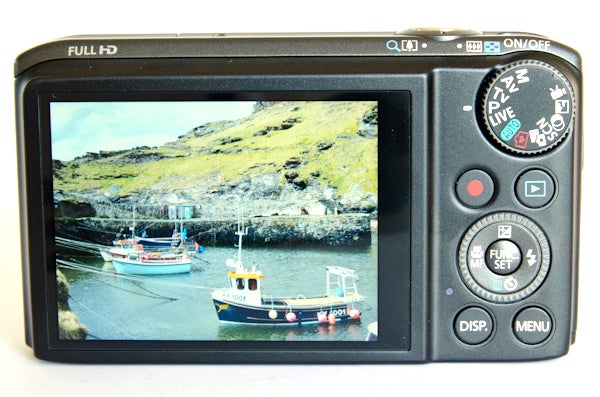
ISO performance is on a par with the competition. At the base sensitivity of ISO 100 images are free of noise, while at ISO 200 the appearance of noise is minimal and only really visible when pixel-peeping images at 100% or more. ISO 400 sees noise become slightly more noticeable, although the SX260 still manages to deliver pretty clean, sharp images. In terms of image quality ISO 800 is the cut-off point; that’s not to say it’s bad, but it’s also the point where the softening effects of the SX260’s built-in noise reduction begins to become visible at smaller image sizes. ISO 1600 is still just about good enough to make small images with, although you can expect images to be pretty soft with a fairly pronounced loss of shadow detail. The top setting of ISO 3200 isn’t great at all though, with a significant loss of detail especially in darker areas.
Verdict
The Canon PowerShot SX260 HS delivers the flexibility of a 20x optical zoom in an easy-to-carry compact sized package. As such it’s a very likeable and easy-to-use travel compact that delivers good results and shows several notable improvements over the model it replaces, not least a longer zoom range and a much needed finger grip. Although it’s relatively well featured and offers a good range of exposure modes the lack of a one-touch Panorama mode remains a bit of an omission, while processing and AF performance isn’t quite top of its class either. In all other aspects though, the SX260 HS is a fantastic little travel compact that’s well worth a closer look if you’re in the market for such a camera.

ISO 100 is sharp, detailed and free of any image degrading noise.

ISO 200 is almost identical to ISO 100 save for a minute loss of shadow detail.

ISO 400 is noticeably softer than ISO 200, although you really need to be viewing the image at 100% (as above).

ISO 800 is the cut-off point, whereby noise begins to visibly impair overall image quality.

ISO 1600 is fairly soft with a fairly prominent loss of shadow detail.

ISO 3200 is the top setting and while it will help you to capture an image in dim light, quality isn’t great.
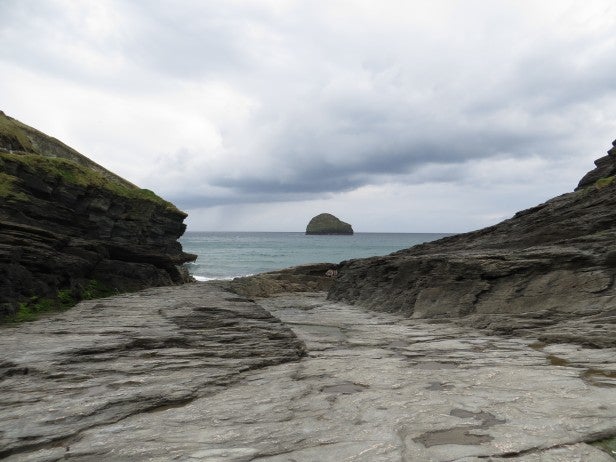
At 25mm the SX260 HS is able to capture wide landscape scenes such as this.

Zoom all the way to 500mm and you’ll just about be able to make out the birds nesting on the island.

The SX260 might ‘only’ have a 12.1MP sensor, but it still captures plenty of detail – especially in good even light.

The camera includes a useful Macro mode that lets you get as close as 5cm away from your subject.

The Smart Auto scene recognition mode does a good job of capturing sunsets.

Even with the My Colours function switched off the SX260 produces pleasingly lifelike colour and good levels of contrast.

In more challenging light, the SX260’s metering is consistently accurate.
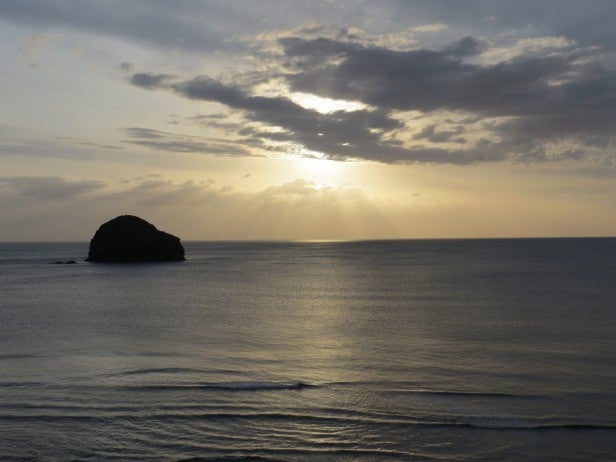
For a small-sensor compact the SX260 delivers very good tonality.
Trusted Score
Score in detail
-
Value 8
-
Design & Features 8
-
Image Quality 8
-
Build Quality 9

